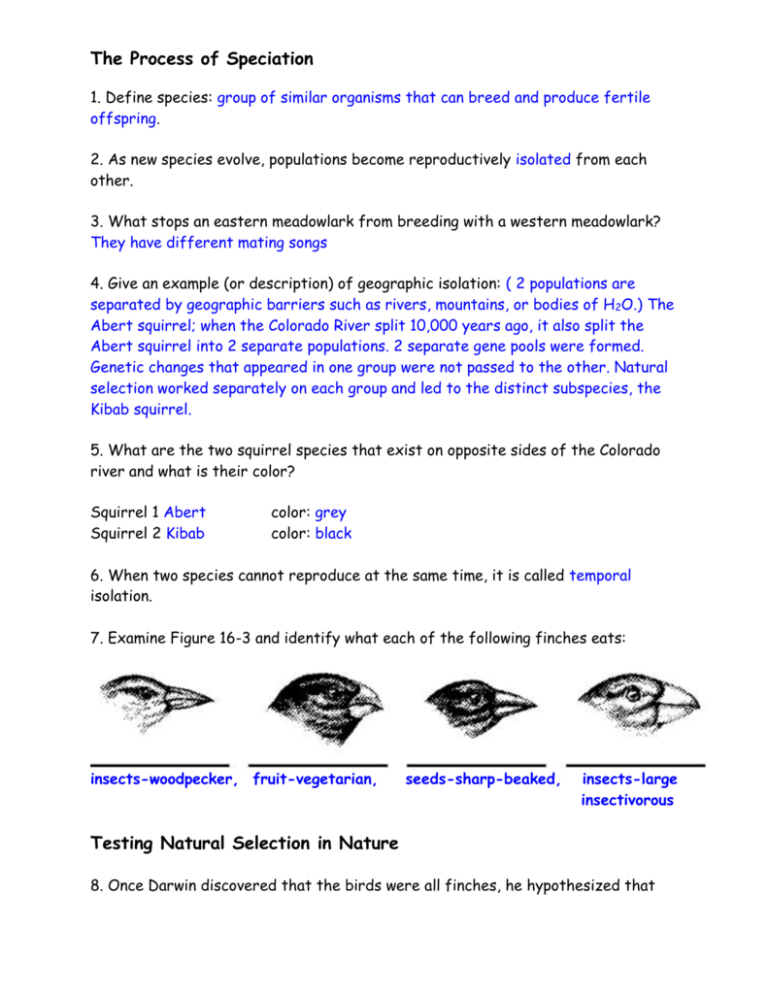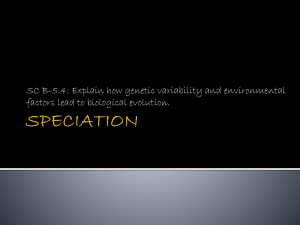Process of Speciation
advertisement

The Process of Speciation 1. Define species: group of similar organisms that can breed and produce fertile offspring. 2. As new species evolve, populations become reproductively isolated from each other. 3. What stops an eastern meadowlark from breeding with a western meadowlark? They have different mating songs 4. Give an example (or description) of geographic isolation: ( 2 populations are separated by geographic barriers such as rivers, mountains, or bodies of H 2O.) The Abert squirrel; when the Colorado River split 10,000 years ago, it also split the Abert squirrel into 2 separate populations. 2 separate gene pools were formed. Genetic changes that appeared in one group were not passed to the other. Natural selection worked separately on each group and led to the distinct subspecies, the Kibab squirrel. 5. What are the two squirrel species that exist on opposite sides of the Colorado river and what is their color? Squirrel 1 Abert Squirrel 2 Kibab color: grey color: black 6. When two species cannot reproduce at the same time, it is called temporal isolation. 7. Examine Figure 16-3 and identify what each of the following finches eats: insects-woodpecker, fruit-vegetarian, seeds-sharp-beaked, insects-large insectivorous Testing Natural Selection in Nature 8. Once Darwin discovered that the birds were all finches, he hypothesized that they descended from a common ancestor. 9. Darwin's hypothesis relied on two testable assumptions: 1) There must be heritable variation in those traits and 2) Differences in shape must produce differences in fitness, that cause natural selection to occur. Peter and Rosemary Grant tested the hypothesis. Complete each statement about their observations. 10. The Grants measured and [ identified / tagged ] as many birds as possible. 11. They recorded which birds [ died / migrated ] and which succeeded in breeding. 12. The purpose of measuring the birds was to show that they have [fitness / variation]. 13. During a [ season / drought ], differences in beak size can mean the difference between life and death. 14. A feeding [ generalist / specialist ] is a type of bird that chooses food based on what its beak handles best. 15. Finches with [ large / small ] beaks were most likely to survive. 16. The next generation of finches had [ larger / smaller ] beaks. Speciation in Darwin's Finches 17. Where did the first finches on the islands come from? South American mainland These first finches were called founders. 18. Over time, populations on the island became adapted to their local environments. 19. How do finches choose their mates? They choose mates with the same size beak. 20. Most specialized birds have less competition for food. 21. How many different finch species can be found on the Galapagos? 13 Studying Evolution Since Darwin 22. New data from what three scientific fields supports the theory of evolution by natural selection? genetics, molecular biology, and evolutionary theory 23. The Grants observed changes in beak size, but they didn't actually see what? Evolutionary change 24. Define SCIENTIFIC THEORY: A scientific theory summarizes a hypothesis or group of hypotheses that have been supported with repeated testing. If enough evidence accumulates to support a hypothesis, it moves to the next step—known as a theory—in the scientific method and becomes accepted as a valid explanation of a phenomenon.











